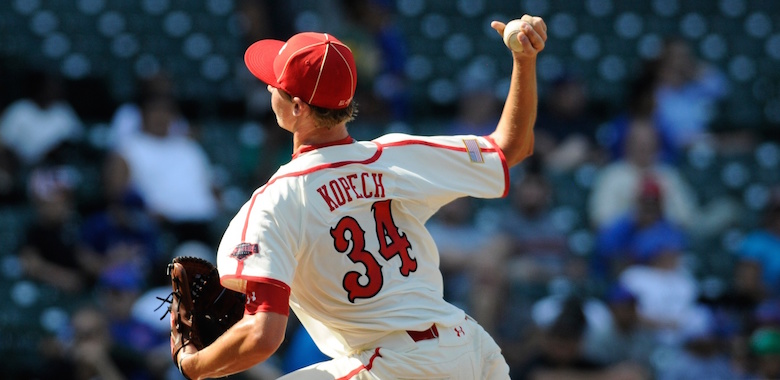When it comes to Red Sox pitching prospects, Boston’s triumvirate of lefties down in Triple-A tend to get most of the attention.
There’s good reason for this, after all. Henry Owens, Eduardo Rodriguez and Brian Johnson have each succeeded against upper-minors competition, and they’re just one stop away from helping the Red Sox at the major league level. Considering all the doubts currently surrounding Boston’s rotation, it’s hard not to gaze longingly toward Pawtucket as Johnson and Rodriguez continue to excel.
Yet one attribute missing among Boston’s top pitching prospects is a top-of-the-rotation ceiling. Owens, Rodriguez and Johnson all have the tools to succeed on a big league staff (and that shouldn’t be taken lightly), but none is likely to develop into the club’s ace of the future.
While we should be careful not to set unrealistic expectations for prospects, one of the most appealing parts of following youngsters down on the farm is being able to imagine what they might ultimately become.
This is what makes Red Sox prospect Michael Kopech someone worth keeping a close eye on. Drafted by Boston with the 33rd overall pick last summer, Kopech is the type of high-ceiling pitching prospect worth dreaming on.
Kopech hails from the state of Texas, and judging by his write-up in BP’s Red Sox prospects list, he has all the attributes you’d expect from a big Texas right-hander. Standing at 6-foot-3, his fastball reaches the upper-90s with arm-side run that overpowers opposing hitters. He complements that with two secondary offerings in a curveball and changeup that already show solid potential, with the curve serving as a strong power pairing with his fastball.
This description of Kopech from BP’s Chris Mellen says it best:
“When gazing off into the distant horizon with this arm, it’s hard not to get overly excited about what the raw talent could round into. Kopech possesses the arm strength and frame that seem to be prerequisites when discussing prototypical power pitchers. The heater explodes out of his hand, showing both arm-side life and hop. It’s an offering that can eventually be downright nasty on opposing hitters. Both the curveball and changeup show the potential to be above-average or better pitches, with an element of ease when delivered and strong clues that each can eventually be very crisp.”
The biggest hurdle for Kopech to overcome right now is his mechanics. He has somewhat of an odd throwing motion that makes repeating his delivery and finding a consistent release point difficult at times. But if Kopech can improve his control and smooth out that delivery, he certainly has the type of stuff to dominate opposing batters.
Struggles with command are typical for pitchers at this point in Kopech’s development track anyhow. The fine-tuning, endurance and consistency needed to succeed against opposing lineups two or three times through the order often come as a pitcher rises higher up the minor league ladder.
This reality makes Kophech’s start to the season down in Low-A Greenville that much more impressive. Through three outings, the 20-year-old has pitched 13.2 innings and allowed just three runs, while striking out 11 batters and walking only two. In his last two starts, Kopech has lasted five frames each, yielding neither a run nor a free pass.
From a development standpoint, Kopech’s strong control early in the season is the most encouraging aspect of his performance. He was expected to struggle with his command (and he still may), but his dominant strikeout and walk numbers indicate he is likely making some strides from a mechanical standpoint. Last summer, for instance, Kopech threw 13.2 innings for the GCL Red Sox and walked nine batters compared to the two walks he has yielded over the same amount of innings this April.
Three strong starts don’t suddenly make him a can’t-miss prospect, even if his early-season dominance is encouraging.
There remain plenty of hurdles for Kopech to clear down in the minors, of course. Three strong starts don’t suddenly make him a can’t-miss prospect, even if his early-season dominance is encouraging. He’ll face far tougher competition once he rises above Low-A, and like any pitcher, Kopech will have to overcome the challenge of staying healthy as his workload increases.
Still, there is little denying how intriguing of a prospect Kopech is, especially in a Boston system stocked with pitchers who have high floors rather than high ceilings. The Red Sox continue to have big expectations for Trey Ball, but he remains a pitcher whose physical development into a top-tier prospect is still a year or two away. With Kopech, you can already see all the ingredients necessary for an elite arm at the big league level.
Kopech could flame out before he reaches Double-A, or his inconsistent mechanics could ultimately relegate him to a bullpen role. Injuries could always play their part as well.
Nevertheless, Kopech is exactly what we as fans hope for in a prospect: a pitcher whose potential you can spend time dreaming about.
Top Photo by Reid Compton/USA Today Sports Images

